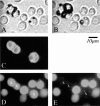Selective cell targeting with light-absorbing microparticles and nanoparticles
- PMID: 12770906
- PMCID: PMC1302982
- DOI: 10.1016/S0006-3495(03)75128-5
Selective cell targeting with light-absorbing microparticles and nanoparticles
Abstract
We describe a new method for selective cell targeting based on the use of light-absorbing microparticles and nanoparticles that are heated by short laser pulses to create highly localized cell damage. The method is closely related to chromophore-assisted laser inactivation and photodynamic therapy, but is driven solely by light absorption, without the need for photochemical intermediates (particularly singlet oxygen). The mechanism of light-particle interaction was investigated by nanosecond time-resolved microscopy and by thermal modeling. The extent of light-induced damage was investigated by cell lethality, by cell membrane permeability, and by protein inactivation. Strong particle size dependence was found for these interactions. A technique based on light to target endogenous particles is already being exploited to treat pigmented cells in dermatology and ophthalmology. With exogenous particles, phamacokinetics and biodistribution studies are needed before the method can be evaluated against photodynamic therapy for cancer treatment. However, particles are unique, unlike photosensitizers, in that they can remain stable and inert in cells for extended periods. Thus they may be particularly useful for prelabeling cells in engineered tissue before implantation. Subsequent irradiation with laser pulses will allow control of the implanted cells (inactivation or modulation) in a noninvasive manner.
Figures









References
-
- Anderson, R. R. 2000. Lasers in dermatology—a critical update. J. Dermatol. 27:700–705. - PubMed
-
- Anderson, R. R., R. J. Margolis, S. Watenabe, T. Flotte, G. J. Hruza, and J. S. Dover. 1989. Selective photothermolysis of cutaneous pigmentation by Q-switched Nd:YAG laser pulses at 1064, 532, and 355 nm. J. Invest. Dermatol. 93:28–32. - PubMed
-
- Anderson, R. R., and J. A. Parrish. 1983. Selective photothermolysis: precise microsurgery by selective absorption of pulsed radiation. Science. 220:524–527. - PubMed
-
- Beck, S., T. Sakurai, B. K. Eustace, G. Beste, R. Schier, F. Rudert, and D. G. Jay. 2002. Fluorophore-assisted light inactivation: a high throughput tool for direct target validation of proteins. Proteomics. 2:247–255. - PubMed
-
- Brinkmann, R., G. Huettmann, J. Roegener, J. Roider, R. Birngruber, and C. P. Lin. 2000. Origin of retinal pigment epithelium cell damage by pulsed laser irradiance in the nanosecond to microsecond time regimen. Lasers Surg. Med. 27:451–464. - PubMed
Publication types
MeSH terms
Substances
LinkOut - more resources
Full Text Sources
Other Literature Sources

